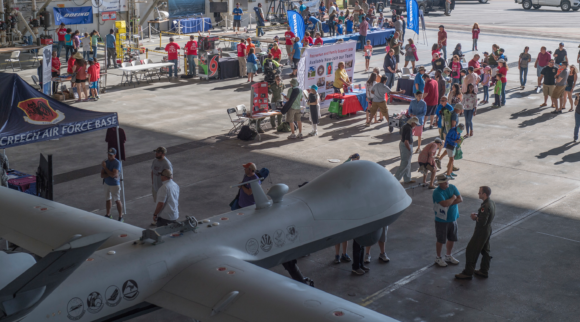Space and STEM showcased at JB Charleston Air and Space Expo
JOINT BASE CHARLESTON, S.C. (AFNS) — Since the 1957 launch of Sputnik, a Russian satellite, Americans have been challenged to step up and become leaders in science, technology, engineering and math — collectively known as STEM. Over the years, there has been a trend in the push for STEM education to younger generations. Recognizing this, Air Mobility Command prioritizes the creation of partnerships with local and public schools to provide insight into the Air Force while enhancing educational experiences.
In conjunction with several partners, Joint Base Charleston showcased both STEM and space through various booths and interactive exhibits at the 2018 Air and Space Expo. Some of the booths included robotics demonstrations, electricity exhibits, moon rock samples and more.
“As military members we practice STEM every single day and most people don’t know that,” said Master Sgt. Kelly Anderson, 628th Communications Squadron superintendent of plans, programs and resources. “The goal was to educate people about STEM and hopefully spark an interest in some of the careers it has to offer. Most people don’t start their freshman year of high school knowing what they want to pursue. They usually reach that point after going through many twists and turns to build that experience moving forward, so hopefully we were able to be one of those twists and turns that helps them decide what they want to do, especially if it’s STEM related.”
STEM education integrates concepts usually taught as separate subjects in different classes and emphasizes the application of knowledge to real-life situations. A lesson in a STEM class is typically based around finding a solution to a real world problem and tends to emphasize project-based learning.
“Space is the next frontier for exploration,” said Cassandra Runyon, College of Charleston associate professor. “Similar to Christopher Columbus sailing America, we’re going out to space and learning more about the environment and weather systems every day. We’re working with the military using STEM routinely to understand the planets and other worlds through a crossover of technologies between NASA and the military.”
Another variation of STEM is STEAM, which includes an added ‘a’ for art. Artistic design is becoming an important part of STEM education because creativity is an essential part of innovation.
“Without STEM we wouldn’t be able to explore space,” Runyon said. “We need each aspect of STEM as well as the materials it provides to create lighter aircraft, better drones, smaller instruments and more. Space is really exciting and inspiring to me because it is unknown and brings up so many questions. I think events like this are really beneficial for kids because they get to see what we accomplish through STEM and hopefully it excites them to consider working in one of our career fields.”
More than 2,000 students from 23 different schools attended and participated in the activities.
“I think this was an awesome opportunity to not only engage the students with the military but also with STEM and space as a whole,” said Megan Wickline, Marrington Middle School of the Arts teacher. “The kids understand the concept of space and what STEM is but they don’t understand all the intricate details that go into actually putting something into the air. Each of the students visiting expressed an interest in STEM-related careers through their career surveys, so I think the hands-on experience was a great way to show them what they could potentially be doing ten years down the road.”
Photo Credit: AF.mil


